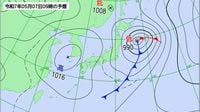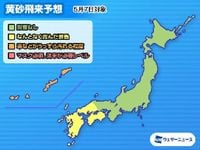On May 7, 2025, the weather in Japan is expected to be mostly sunny, with a significant rise in temperatures across many regions. However, residents should be prepared for some challenges as yellow sand is anticipated to drift in from the west, and there’s a possibility of evening thunderstorms in the inland areas of Kanto.
According to the Japan Meteorological Agency (JMA), the yellow sand, which poses a concern for air quality and visibility, will begin affecting the Japanese archipelago starting on this date. The agency has provided a detailed forecast indicating where the yellow sand will be most concentrated and the expected impacts.
On the morning of May 7, rain is expected to intensify in the Niigata and Tohoku regions, but this will gradually taper off throughout the day. Northern areas like Hokkaido may still experience some rain due to cold air influences, while regions from Tohoku southward are predicted to see improvements in weather conditions as the day progresses. In fact, temperatures in southern Tohoku to Kyushu could increase by about five degrees compared to the previous day, bringing a welcome warmth.
However, as evening approaches, the Kanto region, especially inland areas, may face sudden showers and thunderstorms. This unpredictable weather shift is a reminder for residents to stay vigilant and prepared for possible changes.
In terms of yellow sand, the concentration is forecasted to be particularly high in southern Kyushu and Okinawa, which means that cars and laundry could become noticeably dirty. Unlike pollen, which can be easily brushed off, yellow sand tends to cling to surfaces, making it advisable for people to dry their laundry indoors during this period.
The JMA has noted that yellow sand is expected to remain a concern into May 8, 2025, affecting areas from Okinawa to western Japan. The average number of days with yellow sand observations in May is typically around 2.7 days, suggesting that residents may need to be cautious about this phenomenon for the next few weeks.
For context, April sees the highest frequency of yellow sand, averaging 6.2 days, followed by March at 4.4 days. By June, the average drops to just 0.2 days, indicating that the yellow sand season is nearing its end. Therefore, it seems that after a few more days, the situation will improve significantly.
Looking ahead, the weather forecast indicates that while May 8 will be predominantly clear, rain is expected to return to western Japan on May 9, with potentially heavy rainfall persisting into May 10. By May 11, temperatures are projected to rise sharply in areas west of Kanto, leading to a stretch of unseasonably warm weather.
Okinawa, on the other hand, may start experiencing rain or cloudy conditions around May 10, which could signal the onset of the rainy season. This shift in weather patterns is something to keep an eye on, especially for those planning activities in the region.
As the yellow sand phenomenon continues, the JMA advises those with respiratory conditions to take precautions, such as wearing masks to mitigate any adverse effects. Additionally, individuals concerned about the impact of yellow sand on their belongings are encouraged to avoid outdoor drying of laundry and bedding.
In summary, May 7, 2025, will bring mostly sunny skies and rising temperatures to many parts of Japan, but the looming presence of yellow sand and potential thunderstorms in the Kanto region serve as reminders of the unpredictable nature of spring weather. As always, staying informed through reliable weather updates is crucial for navigating these changes.


